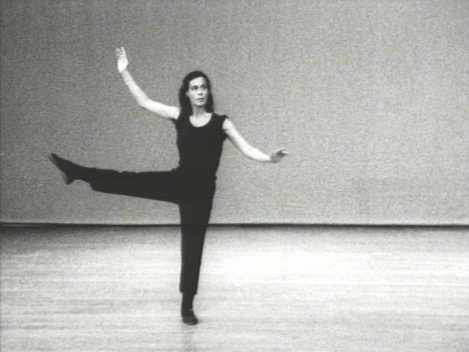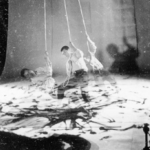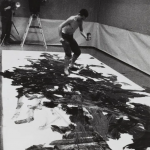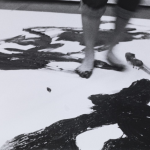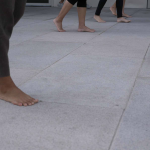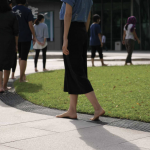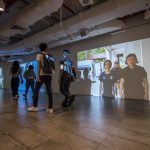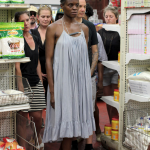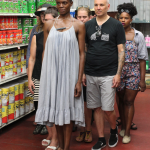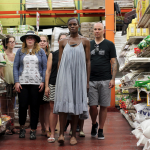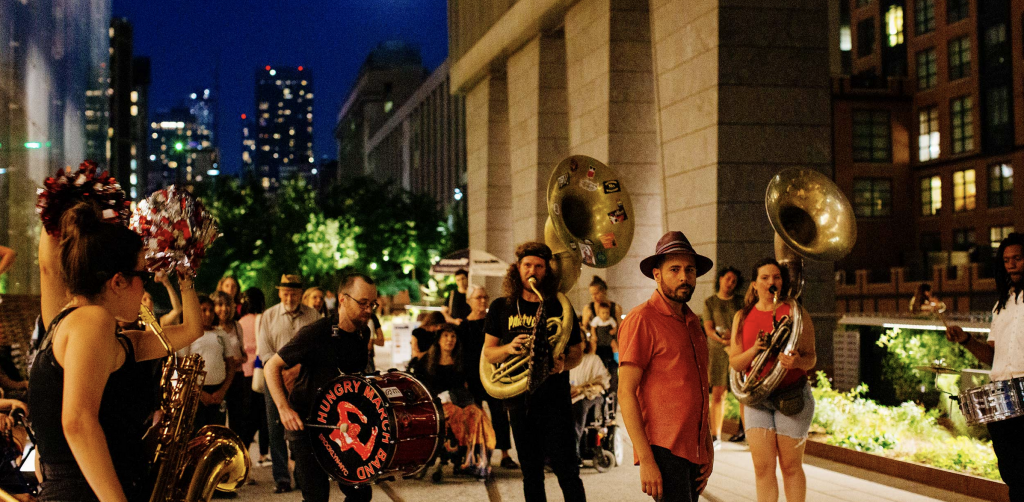This work utilizes equal spacing between each walker – a concept Fulton explored in “Walk dance art co” created by Christine Quoiraud & Hamish Fulton, at Chamarande in 2002 (with 23 other artists).
“At the corner of Bogie Street and Church Street, we get our instructions for today’s choreographed walk. For the next two hours, about 30 of us will walk repeatedly around the same block. We will walk in single file, maintaining a two-metre distance from the person in front. We will not talk.
So the focus of my attention for the next two hours are the heels of Allan Watson, course leader in sculpture at Gray’s School of Art. He’s taller than me, and there are moments when I have to jog to keep two metres between us. Passers-by stop to stare or snigger at this kenspeckle procession. By the fifth circuit, my calf muscles are screaming.
But by the tenth, something strange has happened. My legs don’t hurt anymore. My mind has relaxed. Time feels as if it is liquefying. Has it been ten laps, or 50? It doesn’t matter. I have no demands on my time, nothing is required of me but simply to walk. I wonder, briefly, if this is what it’s like to be Hamish Fulton.
Fulton is the artist who walks. For 40 years, he has made works of art exclusively relating to his walks. He has walked for thousands of miles in five continents. He has walked without sleep, got frostbite, climbed to 8,000m (26,246ft) without oxygen. He has got lost, been caught in storms, fallen down a crevasse (his rucksack wedged, allowing him to climb back out).
More recently, he has begun to choreograph walks involving groups of people, the idea of repetition inspired by the “Marathon Monks” of Mount Hiei in Japan, whose spiritual discipline involves running 40km (25 miles) a day on a repetitive circuit of the mountain. Focusing on the feet ahead of you becomes a secular meditation, a stilling of the mind. “It is a vehicle for a change of mind, a shift in where the mind’s located,” he says, carefully. “I think our minds go round and round and round in the same furrows, and possibly, when you do a walk like this, you go to another part of your mind. It sets in motion a variety of perceptions.
Fulton is in Huntly at the invitation of Deveron Arts, which invites world-class artists to run socially engaged projects in the town. The next day, some of the same walkers joined him on the first day of a 21-day walk in the Cairngorms. Over half a pint of lager in the Huntly Hotel, Fulton reflects that, of all the obstacles he has had to overcome in a lifetime of walking, he has never before been marooned by a cloud of volcanic ash (he eventually arrived by train after his flight to Scotland was cancelled). “It’s incredible, isn’t it? I know it’s costing so much loss of income for lots of people, so I’m sorry for that, but there is something… inspiring about it.
“We see the world in terms of us being able to build everything and make everything. But there are these other things, like volcanos, that we didn’t build. In these times, it’s pretty strange there is this other force, because we’re so used to pushing buttons and Googling data about something.”
Fulton was a contemporary of Richard Long and Gilbert & George at Central St Martins College of Art in the 1960s. He grew up in Newcastle, and his formative experiences of walking were on family holidays to Arran. He was profoundly influenced by a visit to the United States in 1969, when he walked at the site of the Battle of Little Bighorn in Montana and read the work of Native American Luther Standing Bear, who wrote in the 1930s about the Sioux relationship with the Earth. In terms of art, it was an era of exploding potential: art happened outside museums; art was experience; art could be a walk.
The ideas which crystallised at that time have remained consistently central to Fulton’s work. Unlike Richard Long or an artist such as Andy Goldsworthy, he makes no work in the landscape and takes nothing away. The work he makes afterwards – often using photography and graphic text – reflects the walk but cannot reproduce it. The walk and the work are separate creative acts. His work is evocative, but minimalist; Japanese haiku poetry is a key influence. A walk in Wyoming’s Wind River range became just two words: CLOUDS STONES. A road walk across Spain and Portugal is WARM DEAD BIRD. Seven days in the Pyrenees is simply RAIN.
By the time you read this, Fulton will have been in the Cairngorms for four days, carrying his tent, food and fuel. He has no plan, other than to arrive at Glenmore Lodge exactly 21 days after he set out. He will not film or webcast his trip. What happens in the mountains is a mystery, though prosaic details do slip out: one of the most important tools for a serial walker is his nail-clippers. Short toenails are essential for comfort.
“The Cairngorms are like a person, I’m very fond of them. And, of course, anywhere like that is always threatened. So much of the world is either factory, agriculture, roads or housing, as time goes by these spaces are more and more unusual.
“I make the plan up as the days go by, which is extremely luxurious when everything in life has to be so controlled and planned. And then you have loss of control – someone sends you an e-mail, and you have to reply immediately, and then you realise that they sent their e-mail late. All this absurd behaviour that we just slip into.” Stepping into the unknown is a key component. “That’s the difference between making a geometric painting, where you’re fulfilling the plan, and something like this where you’re casting off, and you genuinely don’t know what the outcome can be. It could be a fall, or a wonderful sunrise; you don’t know.”
Fulton is not shy of being political. He is concerned about climate change, but speaks of the need for a profound shift in our relationship with the Earth, rather than simply incorporating a “green economy” into a money-driven system.
Last year, he organised a protest – a walk, of course – for Tibetan freedom, attended by Palden Gyatso, a Tibetan monk imprisoned by the Chinese for 33 years. A recent wall painting bears the words: “GOOGLE PALDEN GYATSO”. Those who do will find a story of torture and endurance. But in China, the link is blocked.
Last May, at the age of 62, Fulton reached the summit of Everest. An artist’s book about his journey will be published this summer. After a lifetime of walking, he was on top of the world.
“It is doing something which is unbelievable. We want a lot of things we want to be unbelievable but they’re not really. In this case, this completely fulfils the objective of doing something that feels unbelievable. The reality doesn’t hit you until five days later.” With that behind him, a forecast of snow in the Cairngorms is hardly a concern. The walking philosopher just shrugs, smiles and heads off into the unknown, one step at a time.” [credit]
